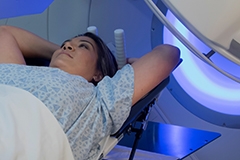External Beam Radiation Therapy – Attacking Cancer from Outside
Medically Reviewed by T. Rhett Spencer, Jr., MD
Bulky machines sit in a darkened room. A bed stretches into the inside of the machine. It may buzz or hum. These machines that direct radiation into cancer are one of the most effective ways to kill, control or shrink tumors.
External Beam Radiation Therapy, Radiotherapy or Cancer Radiation Therapy uses the large machines to generate high energy, highly targeted x-ray, cobalt or particle beams. The beams are focused to hit the tumors inside the body, disrupting the DNA in the tumor. The goal is to kill the tumor cells so that the body sloughs them off.
Treatments are generally painless and the machine doesn’t touch the patient nor does it make the patient radioactive.
Common Types of External Radiotherapy
Traditionally, treatments are 30 to 60 minutes for 5 days a week over 2 to 10 weeks. The radiation beams not only disrupt the cancer cells but also can harm good cells near the cancer.
With advancements in technology, the ability to deliver a more tightly focused beam and multiple computer guided beams have reduced side effects and increased the radiation dose per treatment.
Stereotactic Radio Surgery (SRS) and Stereotactic Body Radiation Therapy (SBRT) represent some of the newest technologies. The term “Surgery” can be confusing, since no real surgery is involved. Using these systems, the length of treatments can be cut to 15 minutes and the number of required treatments reduced to a handful.
Preparing for Treatment
A tremendous amount of planning goes into each patient’s treatment – making it entirely unique to his or her cancer type, location, seriousness, and the person’s general health.
The first step in preparing for treatment is the simulation. Placing the patient on a special X-ray machine or CT scanner, the team determines what the best position is for the patient during treatment. Also, if molds, braces, pads or masks are required to hold the patient in the desired position.
Marks are put on the patient’s body to indicate the exact point, where the beam must be aimed. The marks made with a marker or colored ink look a bit like a tattoo but will eventually fade after the treatments.
The treatment team that you as a patient will meet includes the:
- Patient’s cancer doctor (oncologist). He or she will help determine the patient’s overall diagnosis and treatment, which may involve surgery, chemotherapy or radiation therapy – or some combination.
- Radiation Oncologist. This physician determines what specific sites require treatment. This is called the treatment field. They also determine what dose of radiation needs to be delivered and what areas must be avoided.
- Radiation Physicist works with the radiation oncologist and dosimetrist to determine what particular techniques will be used to make sure the patient receives the proper dose.
- Dosimetrist (dough-SIM-uh-trist) calculates the maximum dosage the patient can receive and then determines the fraction that will be administered each treatment
- Radiation Therapist. They are specially trained to work with patients in delivering the treatments.
Computers play a large role in calculating the dose and ensuring the accuracy of the radiation machine.
During Treatment
When you go in for treatment, DON’T WEAR powder, deodorant, lotion, Band-Aids or jewelry.
You will be placed on a treatment table. Most of the session’s time will involve working with the radiation therapist to position you and aim the beam. You may see colored lights hit your skin. These are for aiming and are not actual radiation. They won’t hurt. The actual treatment may only take a few minutes.
The radiation therapist will be in the other room during the treatment but will be able to talk with you and see you all the time.
Have a question? Ask a Cancer Specialist.
Sources include: McLeod Health, National Institutes of Health, National Cancer Institute, American Cancer Society, Cancer Research UK, National Breast Cancer Foundation, Radiological Society of America
-
McLEOD REGIONAL MEDICAL CENTER FLORENCE
843-777-2000 -
McLEOD DARLINGTON
843-777-1100 -
McLEOD DILLON
843-774-4111 -
McLEOD LORIS
843-716-7000 -
McLEOD SEACOAST
843-390-8100 -
McLEOD CHERAW
843-537-7881 -
McLEOD CLARENDON
803-433-3000



-
McLEOD REGIONAL MEDICAL CENTER FLORENCE
843-777-2000 -
McLEOD DARLINGTON
843-777-1100 -
McLEOD DILLON
843-774-4111 -
McLEOD LORIS
843-716-7000 -
McLEOD SEACOAST
843-390-8100 -
McLEOD CHERAW
843-537-7881 -
McLEOD CLARENDON
803-433-3000
 Find a Doctor
Find a Doctor  Locations
Locations  Services
Services 